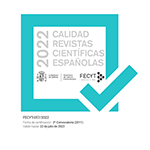Essential oil analysis of eight 'Nepeta' taxa in Iran
Abstract
Nepeta is one of the largest and important genera of Lamiaceae that is found in many parts of the world as wild plants. These aromatic plants produce essential oil for various pharmaceutical and industrial products. The essential oil composition in eight taxa of Nepeta was analyzed. One natural population from each taxon was selected, and their essential oils extracted using Clevenger apparatus. Moreover, GC and GC/MS analysis methods allowed to reveal the variability in essential oil composition and profile among the studied taxa. The oxygenated monoterpenes were dominant in the oils of N. meyeri, N. mirzayanii, N. racemosa, N. binaludensis, and N. glomerulosa. Phytol was the major compound in the essential oil of N. kotschyi var. persica and N. saccharata (11.56% and 27.04%, respectively). 4aα,7α,7aβ-nepetalactone (73.89%) and 4aα,7β,7aα-nepetalactone (83.92%) were the major constituents in essential oil of N. mirzayanii and N. meyeri, respectively. 1,8-cineol was the principal constituent in the oil of N. glomerulosa var. carmanica, N. binaludensis, N. pogonosperma and N. racemosa (23.34%, 43.49%, 53.94% and 70.89%, respectively). The studied taxa were classified into four distinct groups according to the UPGMA tree with high level of bootstrapping support. Each group was characterized by special trait(s) that could be used for identification of them. Therefore, four chemotypes were separated among the studied taxa: 1,8-cineol, 4aα,7α,7aβ-nepetalactone, 4aα,7β,7aα-nepetalactone, and carvacrol. It was also noticed that the composition of essential oil was highly varied compared to previous results.
Downloads
Article download
License
Mediterranean Botany is an open access journal to promote global exchange knowledge. It facilitates unrestricted access to its contents from the moment of publication in its electronic edition. The originals published are property of the Universidad Complutense and it is mandatory to cite such source in case of total or partial reproduction. All contents are distributed under a Creative Commons License 4.0 (CC BY 4.0). This circumstance must be expressly stated in this way when necessary. You can check the informative version and legal text of the license.














